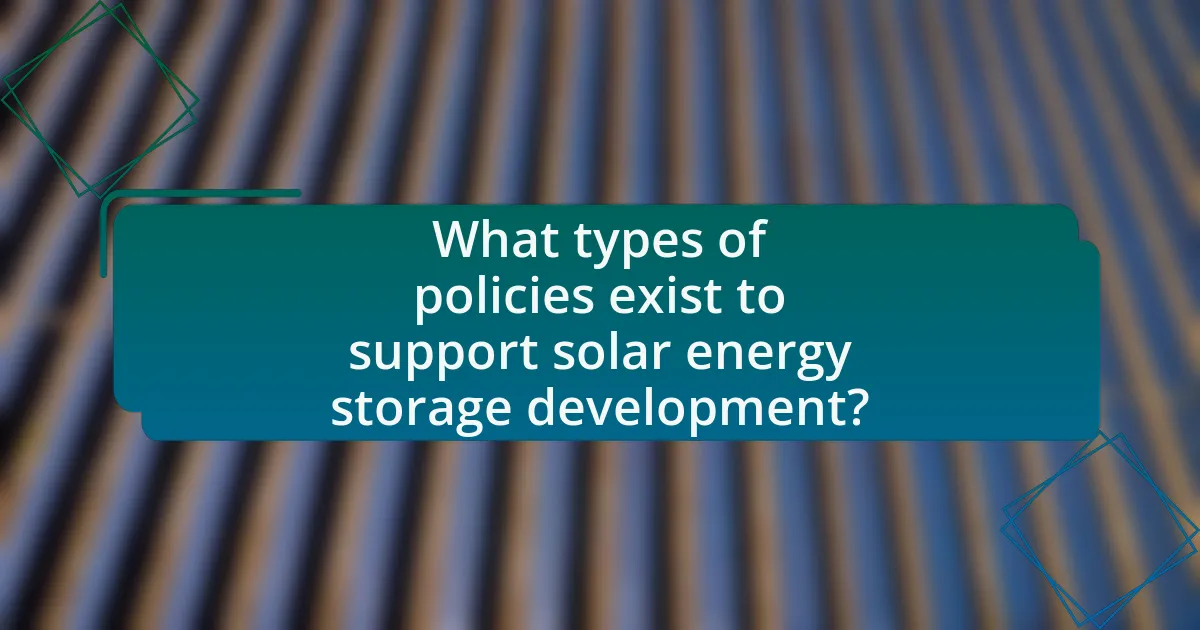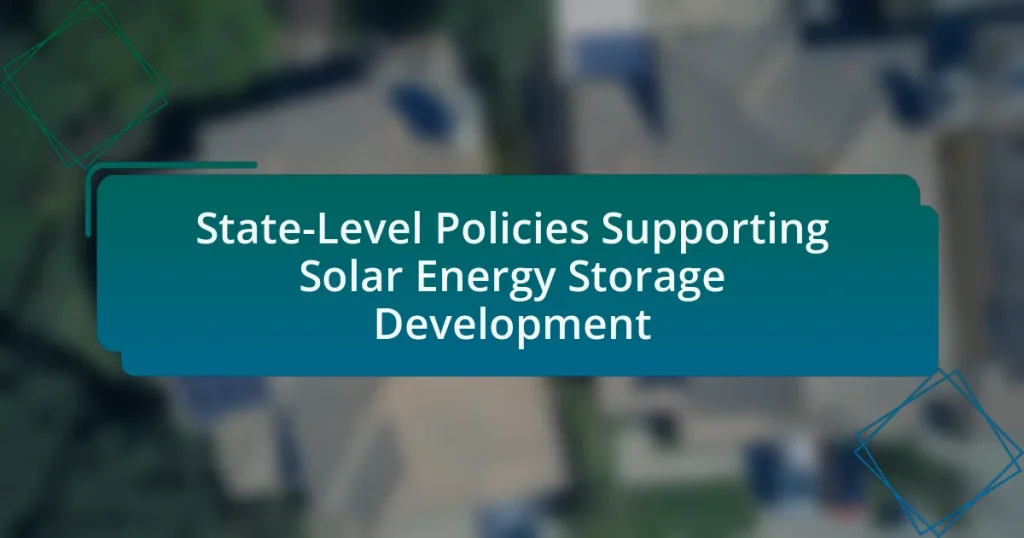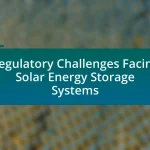State-level policies play a crucial role in supporting the development of solar energy storage by providing financial incentives, regulatory frameworks, and research funding. These policies, which include tax credits, rebates, and streamlined permitting processes, significantly enhance the adoption of solar energy storage technologies across various states. The article examines how these policies impact investment, promote innovation, and address challenges such as high upfront costs and regulatory hurdles. Additionally, it highlights the variations in policy approaches among states, the importance of public-private partnerships, and best practices for enhancing solar energy storage development.
What are State-Level Policies Supporting Solar Energy Storage Development?


State-level policies supporting solar energy storage development include financial incentives, regulatory frameworks, and research funding. For instance, states like California and New York have implemented programs that offer tax credits and rebates for solar energy storage systems, encouraging homeowners and businesses to invest in these technologies. Additionally, policies such as net metering and interconnection standards facilitate the integration of solar storage into the grid, ensuring that energy can be stored and used efficiently. Research funding initiatives, like those from the U.S. Department of Energy, further support innovation in energy storage technologies, enhancing their viability and adoption at the state level.
How do these policies impact solar energy storage adoption?
State-level policies significantly enhance solar energy storage adoption by providing financial incentives, regulatory support, and infrastructure development. For instance, policies such as tax credits, rebates, and grants lower the upfront costs for consumers and businesses, making solar energy storage systems more financially accessible. According to the Solar Energy Industries Association, states with robust incentive programs have seen a marked increase in solar installations; for example, California’s Self-Generation Incentive Program has led to a substantial rise in energy storage capacity, reaching over 1,000 megawatts by 2021. Additionally, streamlined permitting processes and interconnection standards reduce barriers for installation, further promoting adoption. These combined effects demonstrate that supportive state-level policies are crucial in driving the growth of solar energy storage technologies.
What specific goals do these policies aim to achieve?
State-level policies supporting solar energy storage development aim to enhance energy reliability, increase renewable energy integration, and reduce greenhouse gas emissions. These policies are designed to incentivize the adoption of solar energy storage technologies, thereby facilitating a transition to a more sustainable energy system. For instance, states may implement financial incentives such as tax credits or rebates for solar storage installations, which directly encourage consumers and businesses to invest in these technologies. Additionally, policies often include regulatory frameworks that streamline the permitting process for solar storage projects, making it easier to deploy these systems.
How do these policies vary across different states?
State-level policies supporting solar energy storage development vary significantly across the United States. For instance, California has implemented aggressive incentives such as the Self-Generation Incentive Program, which provides financial support for energy storage systems, while states like Texas focus on deregulated markets that encourage private investment in solar storage without extensive state incentives. Additionally, New York has established a comprehensive energy storage target of 3,000 megawatts by 2030, backed by funding programs, contrasting with states like Florida, where policies are less developed and primarily focus on solar generation without specific storage incentives. These variations reflect differing state priorities, regulatory environments, and market conditions influencing the adoption of solar energy storage technologies.
Why are state-level policies crucial for solar energy storage?
State-level policies are crucial for solar energy storage because they establish regulatory frameworks and financial incentives that promote investment and innovation in the sector. These policies can include tax credits, rebates, and grants that lower the cost of solar energy storage systems, making them more accessible to consumers and businesses. For instance, California’s Self-Generation Incentive Program has successfully increased the adoption of energy storage technologies by providing financial support, resulting in a significant rise in installed capacity. Additionally, state-level policies can facilitate interconnection standards and grid integration, ensuring that solar energy storage systems operate efficiently within the existing energy infrastructure. This regulatory support is essential for achieving broader renewable energy goals and enhancing energy resilience.
What role do state governments play in promoting solar energy storage?
State governments play a crucial role in promoting solar energy storage by implementing policies and incentives that encourage investment and development in this sector. These policies often include tax credits, rebates, and grants for solar energy storage systems, which lower the financial barriers for consumers and businesses. For example, California’s Self-Generation Incentive Program provides financial incentives for energy storage projects, significantly boosting adoption rates. Additionally, state governments can establish regulatory frameworks that facilitate the integration of solar energy storage into the grid, ensuring reliability and efficiency. By setting renewable energy targets and mandates, states create a favorable environment for solar energy storage technologies, driving innovation and market growth.
How do these policies influence investment in solar energy storage technologies?
State-level policies significantly influence investment in solar energy storage technologies by providing financial incentives, regulatory support, and market stability. These policies, such as tax credits, rebates, and grants, lower the upfront costs for investors and developers, making solar energy storage projects more financially viable. For instance, California’s Self-Generation Incentive Program offers substantial rebates for energy storage systems, which has led to a marked increase in installations and investments in the state. Additionally, policies that streamline permitting processes and establish clear interconnection standards reduce barriers to entry, further encouraging investment. According to the Solar Energy Industries Association, states with supportive policies have seen a 50% increase in solar storage investments over the past five years, demonstrating the direct correlation between policy frameworks and investment levels in this sector.
What types of policies exist to support solar energy storage development?


Various policies exist to support solar energy storage development, including financial incentives, regulatory frameworks, and research and development programs. Financial incentives such as tax credits, rebates, and grants encourage investment in solar energy storage systems, making them more affordable for consumers and businesses. Regulatory frameworks, including net metering and interconnection standards, facilitate the integration of solar energy storage into the grid, ensuring that stored energy can be efficiently utilized. Additionally, state-level research and development programs promote innovation in solar energy storage technologies, enhancing their efficiency and reliability. These policies collectively aim to accelerate the adoption of solar energy storage, contributing to a more sustainable energy future.
What are the financial incentives provided by state policies?
State policies provide various financial incentives to support solar energy storage development, including tax credits, rebates, grants, and low-interest loans. For instance, states like California offer the Self-Generation Incentive Program (SGIP), which provides cash rebates for energy storage systems, encouraging homeowners and businesses to invest in solar storage solutions. Additionally, tax incentives such as the Investment Tax Credit (ITC) allow for a significant percentage of the installation costs to be deducted from federal taxes, further enhancing the financial viability of solar energy storage projects. These incentives are designed to reduce upfront costs, promote renewable energy adoption, and stimulate economic growth within the clean energy sector.
How do tax credits and rebates work for solar energy storage?
Tax credits and rebates for solar energy storage reduce the overall cost of purchasing and installing energy storage systems. These financial incentives are typically offered by federal, state, or local governments to encourage the adoption of renewable energy technologies. For instance, the federal Investment Tax Credit (ITC) allows homeowners to deduct a percentage of the cost of solar energy systems, including storage, from their federal taxes. As of 2023, this percentage is 30%. Additionally, some states provide rebates that offer direct cash back to consumers after installation, further lowering the upfront costs. These incentives aim to make solar energy storage more accessible and financially viable, promoting cleaner energy solutions.
What funding programs are available for solar energy storage projects?
Various funding programs are available for solar energy storage projects, including federal tax incentives, state grants, and utility rebate programs. The Investment Tax Credit (ITC) allows for a significant tax deduction for solar energy systems, including storage, which can cover up to 26% of the installation costs. Additionally, many states offer specific grants and incentives through programs like the California Solar Initiative or New York’s NY-Sun program, which provide financial support for solar and storage installations. Utility companies often have rebate programs that incentivize the installation of energy storage systems, further reducing upfront costs. These funding opportunities are designed to promote the adoption of solar energy storage, enhance grid reliability, and support renewable energy goals.
What regulatory frameworks are in place for solar energy storage?
Regulatory frameworks for solar energy storage primarily include state-level policies, utility regulations, and federal guidelines. These frameworks often encompass incentives such as tax credits, rebates, and grants aimed at promoting the installation of solar energy storage systems. For instance, the Investment Tax Credit (ITC) allows for a significant percentage of the installation costs to be deducted from federal taxes, thereby encouraging investment in solar storage technologies. Additionally, many states have implemented net metering policies, which enable consumers to receive credit for excess energy generated and stored, further incentivizing the adoption of solar energy storage solutions. These regulations are designed to enhance energy resilience, reduce greenhouse gas emissions, and support the transition to renewable energy sources.
How do interconnection standards affect solar energy storage systems?
Interconnection standards significantly influence solar energy storage systems by establishing the technical requirements for connecting these systems to the electrical grid. These standards ensure safety, reliability, and interoperability, which are crucial for the effective integration of solar energy storage into the existing energy infrastructure. For instance, the Institute of Electrical and Electronics Engineers (IEEE) 1547 standard outlines the performance, operation, and testing requirements for distributed energy resources, including solar storage systems. Compliance with such standards facilitates smoother grid integration, reduces the risk of outages, and enhances the overall efficiency of energy distribution.
What are the permitting processes for solar energy storage installations?
The permitting processes for solar energy storage installations typically involve several key steps, including application submission, site assessment, and compliance with local regulations. First, applicants must submit a detailed application to the relevant local or state authority, which includes project specifications and environmental impact assessments. Following submission, a site assessment is conducted to evaluate the proposed location’s suitability, considering factors such as zoning laws and safety regulations.
Additionally, compliance with building codes and electrical standards is required, which may involve inspections and approvals from various agencies. In many jurisdictions, public hearings may also be part of the process to address community concerns. These processes ensure that installations meet safety, environmental, and regulatory standards, facilitating the responsible development of solar energy storage systems.
How do state-level policies promote innovation in solar energy storage?


State-level policies promote innovation in solar energy storage by providing financial incentives, regulatory frameworks, and research funding. These policies, such as tax credits, grants, and rebates, lower the cost of solar energy storage technologies, encouraging investment and development. For instance, California’s Self-Generation Incentive Program offers financial support for energy storage systems, which has led to significant advancements in battery technology and deployment. Additionally, states may implement renewable portfolio standards that require utilities to incorporate energy storage solutions, driving innovation to meet these mandates. Such policies create a conducive environment for research and development, as evidenced by increased patents and technological advancements in the solar energy storage sector.
What research and development initiatives are supported by these policies?
State-level policies supporting solar energy storage development typically support initiatives focused on enhancing battery technology, improving energy management systems, and advancing grid integration solutions. These initiatives aim to increase the efficiency and reliability of solar energy storage systems, thereby facilitating greater adoption of renewable energy sources. For example, policies may fund research projects that explore new materials for batteries, such as lithium-sulfur or solid-state technologies, which have the potential to significantly improve energy density and lifespan. Additionally, initiatives may include partnerships with universities and research institutions to develop innovative software solutions for optimizing energy storage and distribution, ensuring that solar energy can be effectively utilized during peak demand periods.
How do state policies encourage collaboration between public and private sectors?
State policies encourage collaboration between public and private sectors by establishing frameworks that incentivize joint initiatives and investments. For instance, policies may include tax credits, grants, or subsidies specifically aimed at private companies that partner with public entities on solar energy storage projects. These financial incentives lower the risk for private investors, making collaboration more attractive. Additionally, state policies often create regulatory environments that facilitate public-private partnerships, such as streamlined permitting processes or shared research and development programs. Evidence of this can be seen in states like California, where the California Public Utilities Commission has implemented programs that promote collaboration between utility companies and private solar developers, resulting in increased investment in solar energy storage solutions.
What role do universities and research institutions play in policy development?
Universities and research institutions play a critical role in policy development by providing evidence-based research, expert analysis, and innovative solutions that inform decision-making processes. They contribute to the understanding of complex issues, such as solar energy storage, by conducting studies that assess technological feasibility, economic impacts, and environmental benefits. For instance, research conducted by institutions like Stanford University has demonstrated the potential for solar energy storage to enhance grid reliability and reduce greenhouse gas emissions, thereby influencing state-level policies aimed at promoting renewable energy initiatives. This empirical evidence supports policymakers in crafting regulations and incentives that foster the growth of solar energy storage systems.
How do these policies address challenges in solar energy storage?
State-level policies address challenges in solar energy storage by providing financial incentives, regulatory frameworks, and research funding that enhance storage technology adoption and integration. For instance, policies such as tax credits and rebates lower the upfront costs for consumers and businesses investing in solar storage systems, thereby increasing market penetration. Additionally, regulatory measures streamline the interconnection process for storage systems, facilitating easier integration with the grid. Research funding supports innovation in energy storage technologies, leading to improved efficiency and reduced costs. These combined efforts create a supportive environment that mitigates barriers to solar energy storage deployment.
What barriers to adoption do state policies aim to overcome?
State policies aim to overcome barriers to the adoption of solar energy storage, including high upfront costs, regulatory hurdles, and lack of consumer awareness. High initial investment costs deter potential adopters, making financial incentives and subsidies essential for encouraging uptake. Regulatory hurdles, such as complex permitting processes and interconnection standards, can delay or prevent installation; thus, streamlined regulations are necessary to facilitate quicker deployment. Additionally, a lack of consumer awareness about the benefits and functionalities of solar energy storage systems can hinder adoption, which state policies address through educational initiatives and outreach programs.
How do policies ensure equitable access to solar energy storage solutions?
Policies ensure equitable access to solar energy storage solutions by implementing regulations and incentives that promote affordability and accessibility for all demographics. For instance, state-level policies may include financial incentives such as rebates, tax credits, or grants specifically targeted at low-income households, which help reduce the upfront costs associated with solar energy storage systems. Additionally, policies can mandate that utility companies offer equitable rates for energy storage services, ensuring that all consumers, regardless of income, can benefit from these technologies. Research from the National Renewable Energy Laboratory indicates that inclusive policies can increase adoption rates among underserved communities, thereby enhancing overall energy equity.
What best practices can states adopt to enhance solar energy storage development?
States can enhance solar energy storage development by implementing supportive policies and financial incentives. These measures include establishing tax credits for solar storage systems, which can significantly lower installation costs and encourage adoption. Additionally, states can create grant programs to fund research and development of advanced storage technologies, fostering innovation in the sector.
Furthermore, integrating solar energy storage into existing renewable energy standards can ensure that a certain percentage of energy comes from storage solutions, promoting their use. States can also streamline permitting processes for solar storage installations, reducing bureaucratic hurdles and expediting project timelines.
Finally, public-private partnerships can be encouraged to leverage private investment in solar storage projects, enhancing overall capacity and efficiency. These best practices have been shown to increase solar storage deployment, as evidenced by states like California, which has seen substantial growth in solar storage capacity due to such initiatives.
How can states effectively measure the impact of their policies?
States can effectively measure the impact of their policies by utilizing a combination of quantitative metrics and qualitative assessments. Quantitative metrics include tracking key performance indicators such as the increase in solar energy storage capacity, the reduction in energy costs, and the number of installations over time. For instance, California’s solar energy policies have led to a significant increase in installed solar capacity, which can be quantified through data from the California Energy Commission. Qualitative assessments involve gathering stakeholder feedback, conducting surveys, and analyzing case studies to understand the broader social and economic impacts of the policies. This dual approach allows states to comprehensively evaluate the effectiveness of their solar energy storage initiatives.
What lessons can be learned from states with successful solar energy storage programs?
States with successful solar energy storage programs demonstrate the importance of comprehensive policy frameworks that incentivize investment and innovation. For instance, California’s Self-Generation Incentive Program provides financial incentives for energy storage systems, resulting in a significant increase in installed capacity, which reached over 1,000 megawatts by 2021. Additionally, states like Massachusetts have implemented renewable portfolio standards that require utilities to procure a certain percentage of energy from renewable sources, including storage solutions, fostering market growth. These examples illustrate that targeted financial incentives and regulatory support can effectively drive the adoption of solar energy storage technologies.


